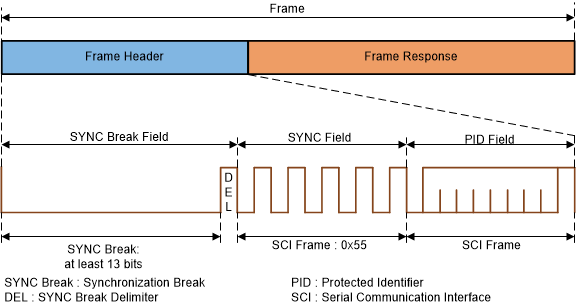SLLA383A February 2018 – August 2022 SN65HVDA100-Q1 , SN65HVDA195-Q1 , TLIN1022-Q1 , TLIN1029-Q1 , TLIN2022-Q1 , TLIN2029-Q1 , TMS320F28P550SJ , TMS320F28P559SJ-Q1
2.4 Message Frame Format
Every LIN message has a specific structure: the first part being the token and the second part data (the Header and the Response). The token is always transmitted by the commander task, and is divided up into the sync break, sync field, and the protected identifier (PID). The sync break and sync field are used to have all the responders on the LIN bus synchronized to the commander's timing (without the need of any crystal or oscillator), and the PID is what defines which responder responds, receives, or ignores the message header being sent. The header in total consists of at least 13 bits for the SYNC break, 1 delimiter bit, 10 SYNC field bits (1 start bit, 8 bits for synchronization, and 1 stop bit), and 10 identifier bits (1 start bit, 6 bits for the identifier, 2 bits for parity, and 1 stop bit).
 Figure 2-2 LIN Frame Header Explanation
Figure 2-2 LIN Frame Header ExplanationThe Data (response) portion of the message is sent by the responder task, which can be sent by the commander or the responder node depending on the PID “instruction”. The Response is broken up into data bytes (up to 8), and a checksum. The checksum is a protection scheme for the data bytes, it verifies that the message sent is what was intended, and that no errors were introduced during transmission. Any node can receive the frame response, but which node actually does use it, is dependent on the LDF. The response in total consists of 10 bits for each byte of data (1 start bit, 8 bits for data, 1 stop bit), for up to 8 data bytes, and 10 bits for checksum (1 start bit, 8 bits for checksum solution, 1 stop bit).
 Figure 2-3 LIN Frame Response
Figure 2-3 LIN Frame Response